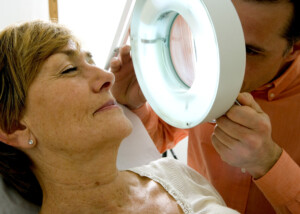Bald Patches Above Cat’s Eyes: Causes and Solutions

If your cat has bald patches above its eyes, you may be worried that cancer might be a possible cause.
There are actually several possible causes of bald patches—loss of fur—occurring above a cat’s eyes. (more…)
Why Do People Let Basal Cell Carcinoma Progress to Disfigurement?

Ignoring something that looks like a pimple is one thing, but there actually exist people in industrial societies who ignore basal cell carcinoma even after it has turned their face into a grotesque form. (more…)
What Are the Odds of a Basal Cell Carcinoma Metastasizing?

There actually are cases in which basal cell carcinoma, sometimes called a non-spreading cancer, has metastasized to the lungs, bones and other crucial parts of the body.
You’ve probably read that basal cell carcinoma “can’t spread” or “doesn’t spread,” but does cause “local destruction” if not treated.
But basal cell carcinoma CAN spread — and kill.
“Unlike melanomas, basal cell carcinomas (BCCs) usually do not metastasize but instead spread locally,” says Dr. Tess Mauricio, MD, FAAD, a leading board certified dermatologist from Stanford University Medical School and CEO of MBeautyClinic.com.
“However, if BCCs are allowed to spread without treatment, there could be a chance for metastasis,” warns Dr. Mauricio.
What are the chances of basal cell carcinoma metastasis?
The chances, in terms of percent, have not been determined. However, check out the following:
Metastasis of basal cell carcinoma (BCC) rarely occurs. Few cases have been reported in the literature.
…the occurrence of BCC metastasis is exceedingly rare, with an average rate of approximately 0.03%, typically involving a large, long-standing, locally destructive, recalcitrant tumor of the head or neck.
Cutis, July 2007
To put this in more perspective, here are intriguing excerpts from DermatologyTimes (April 2010).
A search of the current literature shows that only about 350 cases of metastatic BCC (MBCC) have been reported.
However, with 1 million new cases of BCC every year in the United States alone, Dr. Giannelli says it is very hard to believe, and highly unlikely, that these metastases do not occur more frequently than they are actually reported.
From the Journal of the American Academy of Dermatology (August 2008):
Basal cell carcinoma (BCC), the most common human malignancy, metastasizes in 0.0028% to 0.5% of cases, usually to the lymph nodes, lungs, bones, and skin.
After metastatic spread of BCC, survival averages 1 to 2 years.
Some Considerations
Logic says that if left untreated, it will metastasize if the patient lives long enough.

The bump near the nostril is an early BCC. KarmoutsosV, CreativeCommons
Nobody knows just how many people, who never sought medical attention for the BCC growing on their face, behind their neck or on their scalp, would have eventually been diagnosed with a metastatic basal cell carcinoma had their lives not been cut short by a car accident, homicide, pneumonia, hip fracture, primary breast cancer or primary prostate cancer.
Think of elderly people with no health insurance who notice an early stage BCC on their already age-ravaged face.
They ignore the lesion, perhaps suffering from dementia, unable to realize that the progressing lesion is eating away at their nose, ear or whatever structure is nearby.
It’s not uncommon for very elderly people to already have benign though worrisome-looking lesions and bruises on their skin.
They may then blow off the developing skin cancer as just another part of aging.
But what about middle aged people (who don’t have age related cognitive impairment) who ignore a BCC until it causes so much local destruction that they finally see a doctor — and by then it has spread?
Again, cognitive and psychiatric issues (not necessarily age related) need to be considered as to why a person would disregard a clearly-worsening lesion on their skin, especially on their face and near their eyes — even if they do not have medical insurance or have a fear of doctors.
“Denial is a strong defense mechanism, which can lead to an amazing delay in seeking medical attention,” says Ted Rosen, MD, in an article about multiple BCCs at pediatricsconsultantlive.com.
He refers to the case below (warning: graphic image), though the 74-year-old patient’s disease was not metastatic.

Closing Thoughts
Basal cell carcinoma is typically included with squamous cell carcinoma (a more serious skin cancer) when it comes to mortality statistics.
BCC is not tracked by central cancer registries, says the Centers for Disease Control website.
Though death from basal cell carcinoma has happened, it is so rare that if you’re ever diagnosed with this skin cancer, it would be quite unreasonable for you to worry for your life – unless you’ve allowed the growth to develop over many years to the point where it has caused gruesome local destruction.
These cancers are very slow growing (can grow 20 years and still not have metastasized), but time lapse doesn’t stop their growth.
Death by basal cell carcinoma does not always mean metastasis.
Locally advanced BCC can actually cause death, not to mention permanent vision loss (depending on original location).
Local destruction can involve infiltration into neighboring bone or muscle, but this does not mean metastasis.
So again, basal cell carcinoma grows at a snail’s pace, but a long-enough time lapse can result in metastasis and even deadly local destruction.
 Dr. Mauricio is an internationally recognized cosmetic surgeon and the youngest woman to hold the position of President of The San Diego Society for Dermatologic Surgery.
Dr. Mauricio is an internationally recognized cosmetic surgeon and the youngest woman to hold the position of President of The San Diego Society for Dermatologic Surgery.
 Lorra Garrick has been covering medical, fitness and cybersecurity topics for many years, having written thousands of articles for print magazines and websites, including as a ghostwriter. She’s also a former ACE-certified personal trainer.
Lorra Garrick has been covering medical, fitness and cybersecurity topics for many years, having written thousands of articles for print magazines and websites, including as a ghostwriter. She’s also a former ACE-certified personal trainer.
.
Top image: Shutterstock/Dermatology11
Sources:
cdc.gov/cancer/skin/statistics/index.htm
mdedge.com/cutis/article/67545/nonmelanoma-skin-cancer/extensive-basal-cell-carcinoma-probable-bone-metastasis
dermatologytimes.modernmedicine.com/dermatology-times/news/modernmedicine/modern-medicine-feature-articles/metastatic-basal-cell-carcino
sciencedirect.com/science/article/pii/S019096220701328X
pediatricsconsultantlive.com/articles/multiple-basal-cell-carcinomas
jamanetwork.com/journals/jamadermatology/fullarticle/2478036
dermatologytimes.modernmedicine.com/dermatology-times/content/tags/advanced-basal-cell-carcinoma/role-dermatologist-diagnosing-managing-?page=full
Cause of Sudden Pain in Dog Ear Many Weeks after Mastectomy

That little dog ear has caused you no problems but suddenly it’s painful—many weeks after your mastectomy.
What could this mean? First of all, even though the pain may have a sudden barb-like quality, there’s no reason to panic – assuming that you’re many weeks out from your mastectomy and have not had any infections or other complications. (more…)
Dread Turning 50? How to Celebrate the Big 5-0 & Feel Young

Are you becoming increasingly despondent because your 50th birthday is coming up?
It’s one thing to hear people tell you things like, “Some people never make it to 50,” or, “Pretend a decade is 12 years; you’ll be forty-ten!” (more…)
Can a Mole Be Stretched and Permanently Lengthened?

A mole that appears to be elongating or stretching out may make you fear melanoma.
So in an attempt to reassure yourself, you convince yourself that normal moles can be stretched permanently if the skin has been stretched. (more…)
Mole Grew Back Rapidly After Shave Biopsy Was Normal

You recently had a mole removed with a shave technique; the biopsy was normal; and now the mole is already growing back quite fast.
Melanoma could very well be the first thing that pops into your mind, as you did not expect the mole to grow back, let alone so quickly, after a shave removal. (more…)
Maximum Number of Moles that Can Be Removed at the Same Time

Your body is peppered in moles and you’re scared of melanoma or just hate the look, so just how many of your moles can be removed at the same time by a dermatologist? (more…)
Can Melanoma Grow Inside a Pimple?

What makes the question of can melanoma grow inside a pimple even more confounding is that there are some melanomas that can easily pass for a typical pimple.
Melanoma Growing Inside a Pimple
“Melanomas and pimples (acne) are two completely unrelated skin diseases,” begins Estee Williams, MD, a board certified medical, cosmetic and surgical dermatologist and assistant clinical professor in dermatology at Mount Sinai Medical Center.
She explains, “It would be a rare coincidence if a melanoma were to grow within an ordinary pimple.”
Can pimples cause melanoma?
Never. A pimple, no matter how many you have or how “bad” your acne is, will never raise the risk of melanoma.
“I do want to mention that any ‘pimple’ that does not heal after one month or so should be checked by a dermatologist since, sometimes, melanoma can look like a red bump and be mistaken for a pimple,” says Dr. Williams.
The type of melanoma that often looks very much like an innocent pimple is the nodular type, below.

Basal cell carcinoma, the most common cancer in the world, can also easily look like a pimple – but its development is never related to the presence of pimples or acne.
Do not confuse the concept of “cause” with “arise within by coincidence.”
A melanoma can grow anywhere on the skin. A pimple is not protective against DNA mutations that lead to cancer.
Thus, check your pimples – or rather, what appear to be benign blemishes – for suspicious signs, which, as Dr. Williams mentioned, include inability to heal.
If a melanoma is actually growing inside a pimple, this is a coincidence only.
Acne can obscure visible signs of any skin cancer, so take extra care to inspect portions of your skin that are covered with acne.

Dr. Williams strives to be at the forefront of her field, being active in local, national and international medical and cosmetic dermatology conferences.
 Lorra Garrick has been covering medical, fitness and cybersecurity topics for many years, having written thousands of articles for print magazines and websites, including as a ghostwriter. She’s also a former ACE-certified personal trainer.
Lorra Garrick has been covering medical, fitness and cybersecurity topics for many years, having written thousands of articles for print magazines and websites, including as a ghostwriter. She’s also a former ACE-certified personal trainer.
Can Bra Strap Irritation Turn a Mole into Melanoma?
If your bra strap keeps irritating a mole, can this make it turn into a deadly melanoma?
Many women are worried that continuous irritation from a bra strap can cause a mole to develop into melanoma. (more…)





























































